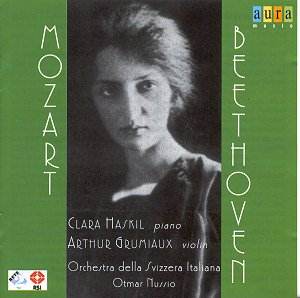I often think of the Szymon Goldberg-Lili Kraus duo
when I think of Grumiaux and Haskil and not merely because of the alignment
of the sexes. Both were superbly equipped instrumentally and temperamentally
and both were elite duos when it came to the core, classical and early
romantic repertoire. They observed and obeyed the functions and proprieties
of the music they played vesting it with warmth and discernment; stylistically
apposite without sacrificing their romantic sensibilities; tonally expressive
without exaggeration; a kinship that survived the vagaries of touring
and disparities of ambition and location. In the case of the Grumiaux-Haskil
duo this also involved disparities in age – he was 29 and she well into
her fifties when they began their music making together – but also the
duo witnessed a remarkable consonance of aesthetic understanding that
led to over a decade of stellar musicianship.
Their commercial discography – Mozart, Beethoven and
Schubert principally – has of late been expanded, or replicated by broadcast
and live performances, of which Aura have now given us two, the
other devoted to Mozart and Beethoven Sonatas. Grumiaux recorded
the Op 30 No 2 twice commercially for Philips – with Haskil and with
Arrau. Here in Ascona in 1959 he retains vestiges of the more effulgent
player who so startled on his early 1950s Boston recordings. This fiery
expressivity has been softened somewhat but the opening movement is
still galvanized and energetic, the Andante cantabile has a splendid
series of collective dynamics and the Scherzo has real brio. The violinist
has a few incidental and passing problems – especially on the G string
– but it won’t perturb his many admirers.
Haskil plays the A Major Mozart Concerto with Otmar
Nussio conducting the orchestra of which he had been in charge since
1938 (he had been taught by Respighi, was also a flautist - in which
capacity he recorded - but his commercial discography is witheringly
small and he’s probably better known for surviving off-air recordings
such as this one). Touches of heaviness do occasionally intrude in the
first movement of the concerto but are generally dispelled whilst in
the Adagio Haskil’s strongly accented playing vests the movement with
a rather theatrical verticality rather than the limpidity with which
it is usually played. The finale goes quite well – not ideally clear
perhaps but relatively buoyant.
Piero Rattalino’s notes are eccentric and scatter-shot
but at least you won’t nod off reading them. The recital admirably meets
Aura’s ambitious programme in releasing live material the better to
enrich and reflect upon the discographies of such great artists as Grumiaux
and Haskil.
Jonathan Woolf
AVAILABILITY
www.aura-music.com


